Want to play Master of Puppets the right way? Here's how to get faster at downpicking so you can chug like James Hetfield
Downpicking is a fundamental and powerful pick stroke, and one of the mainstay techniques in metal and punk

Any time spent in the world of metal and rock guitar playing will have downpicking show up sooner rather than later.
It's because so many bands, ranging from Slayer to Megadeth and Meshuggah to Killswitch Engage, rely on down picking to create their riffs.
For many, the player most revered and credited fror the technique is Metallica's James Hetfield. With its use in so many of the band's iconic songs, he has been a vital source of inspiration for countless guitarists over several decades.
The essence of downpicking is a pick motion starting on top of one string (or perhaps two strings to sound a power chord) and then striking it, moving the pick towards the ground in one small motion.
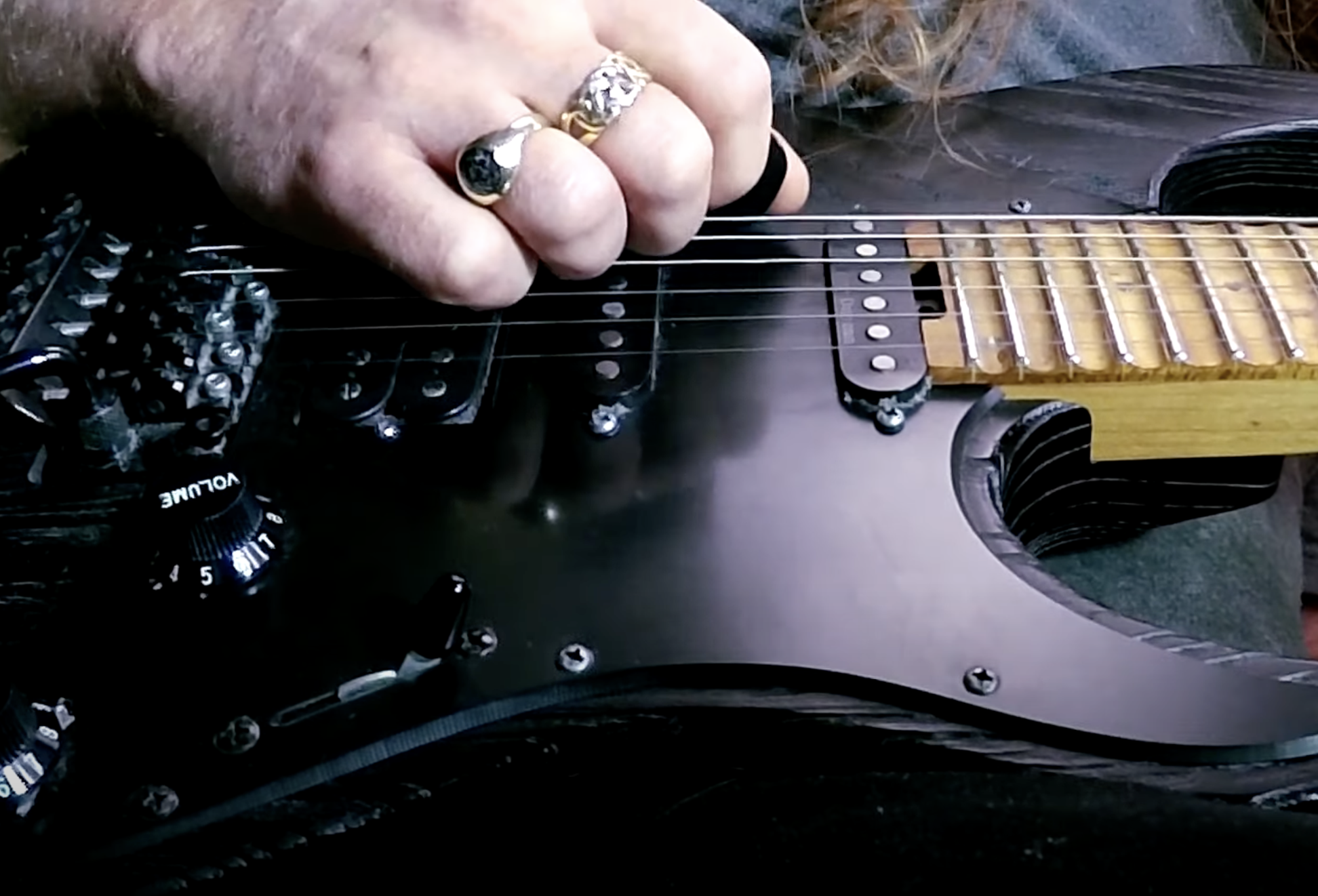
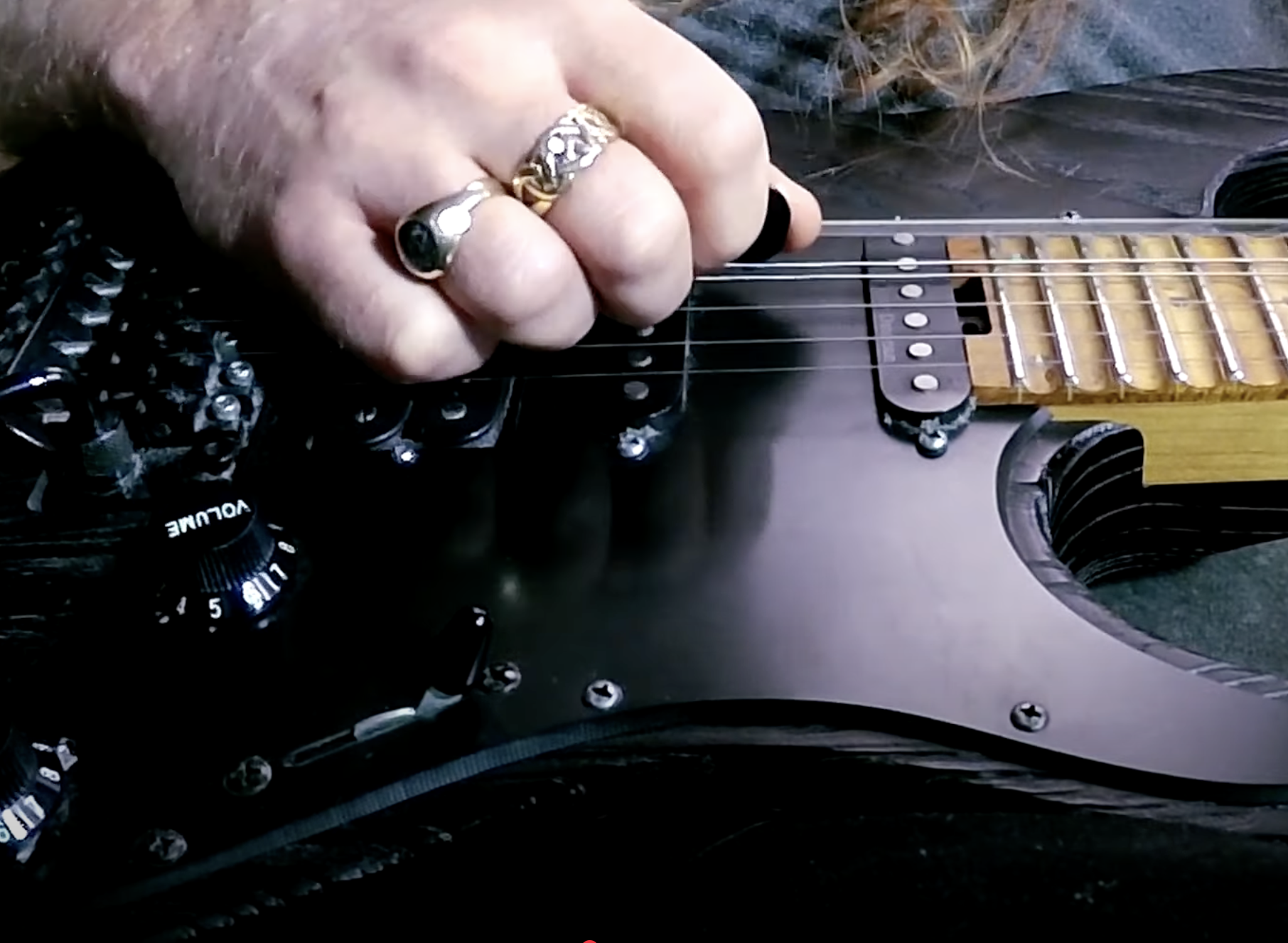
To repeat the down-pick you will need to return to the original position by moving your pick up, towards your head. This up-pick will not sound or connect with the string, though, so consider it a 'ghost' stroke – it occurs but is not heard.
The combination of a heard down-pick and a silent up-pick will allow you to play powerful riffs, emphasize a melodic sequence, or accent notes and chords.

In this article, the fundamentals of downpicking are covered so you can establish a solid technique foundation. Then, you'll move on to a series of exercises designed to improve speed, clarity and control.
Tab examples
Example 1 - downpicking primer
This exercise is a primer for developing steady downpicking. Keep your picking motion controlled by using your wrist instead of your arm, and make sure each note is played with the same pick angle and velocity.
Don't forget up-picks are silent after each down pick.
There are four downpicked low E notes in the first bar (each is a 1/4 note - a quarter note - long). The next bar is silent so you've time to rest and reflect. Bars three and four are the same as bars one and two. It can be tempting to speed up, so pay close attention to the consistent tempo provided by the drums.
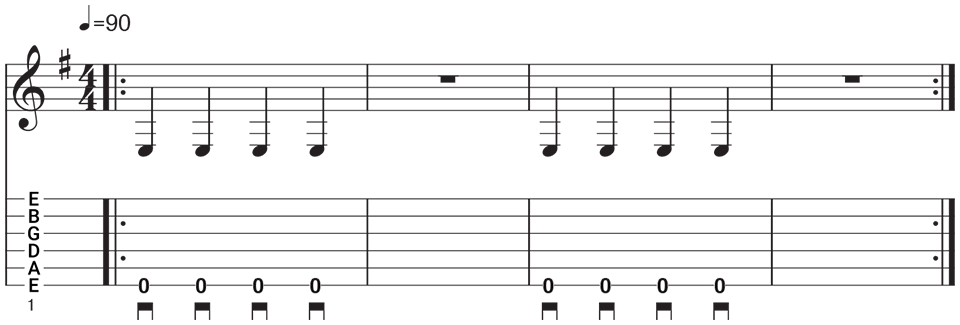
Example 2 - 1/4 and 8th note downpicking
This is a combination of down picked 1/4 notes and 1/8th notes (typically called 8th notes). The 8th notes here mean 8 notes in each bar of 4/4 but it's easier to count each bar like this so the main 1/4 note beats are clear: 1 & 2 & 3 & 4 &’.
The played 8th notes occur at beat 3 of bars 1-3 where two down picks are used. Be careful you don't tense up too much with the faster 8th notes and watch your silent up pick doesn't get caught on a string.
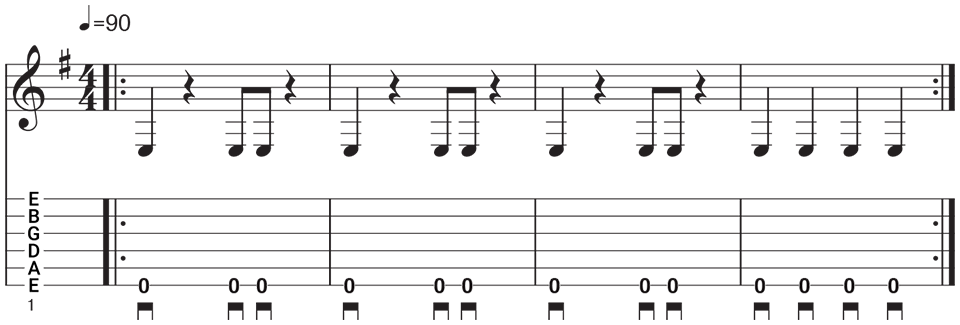
Example 3 - downpicked power chords
In this exercise, you’ll continue with the 8th note feel, but now with power chords (two note chords of root and 5th) with more emphasis on the ‘&’ of each beat.
By highlighting the weaker parts of the bar (that is, the '&'), you create syncopated phrases which sound appealing. As for the powerchords used, Bb5 isn't in the commonly used E Aeolian mode (E-F#-G-A-B-C) or even the spicier E Phrygian mode (E-F-G-A-B-C). The latter mode is more relevant here due to the F5 chord in bar 4.
The Bb note in Bb5 could be considered from the E blues scale, though - E-G-A-Bb-B-D.
Theory aside, it's all very metal-sounding!
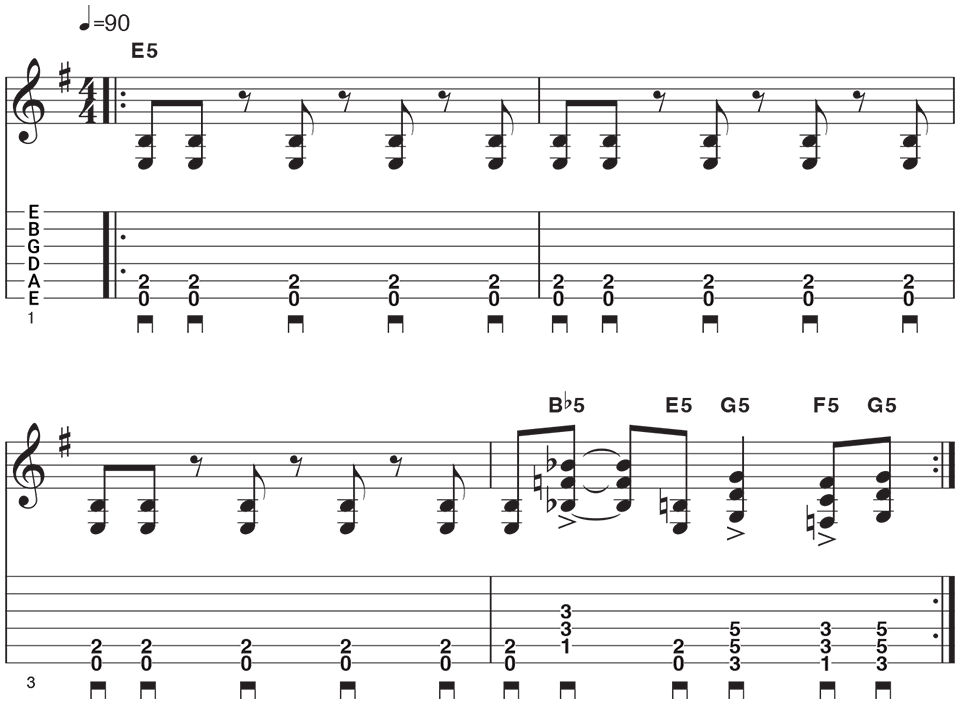
Example 4 - downpicked triplets
This exercise features 8th note triplets (three notes played per beat counted either as 1 & a, 2 & a or straw-be-ry, straw-ber-ry) to speed up the rhythms and bring you closer to hard rock and metal stylings.
Palm muting (shown as PM above the tab) is a fantastic picking hand technique for rhythmic clarity and tightness. However, be careful not to press your picking hand's palm too hard or too far over the strings as this can alter and/or muddy note clarity. For more on palm muting, check out this extensive lesson.

Example 5 - 16th-note downpicking
Now you’ll work with 16th notes, counted here as ‘1 e & a, 2 e & a, 3 e & a, 4 e & a’. To create breathing space, you'll play two 16th notes and an 8th note on beats 1 and 3, and rest on beats 2 and 4.
Use the pauses to relax your picking hand and avoid fatigue.
This 16th-16th-8th rhythm is called the reverse gallop: for more on gallop rhythms check out our lesson on the topic.
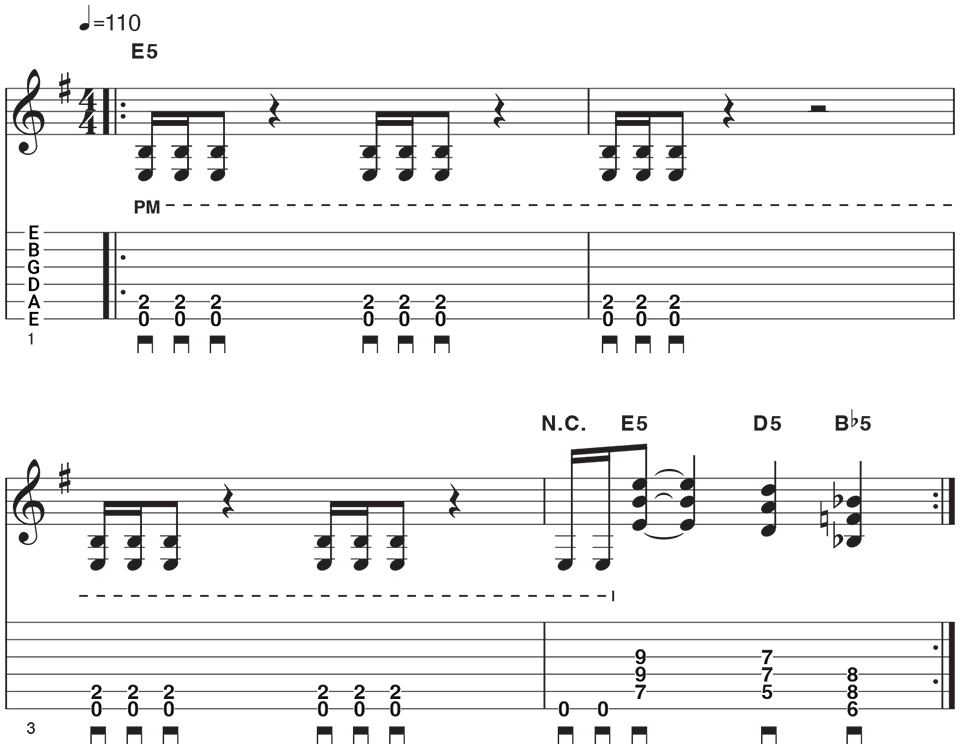
Example 6 - 16th-note stamina with downpicking
In this final exercise, you'll play all four notes in each 16th note grouping.
Pay attention to the accents in bars 2 and 4 (shown as > under the notation), as they provide contrast within the long 16th-note sequences.
When using palm muting, it's common to create accents, not by playing harder (although that is an option) but by reducing the muting effect (or indeed, not using it at all).
This contrast results in open, bright notes (no palm muting) for the accents and tight, bassier notes (palm muted) for the regular 16ths. Keep your picking arm relaxed to prevent tension.
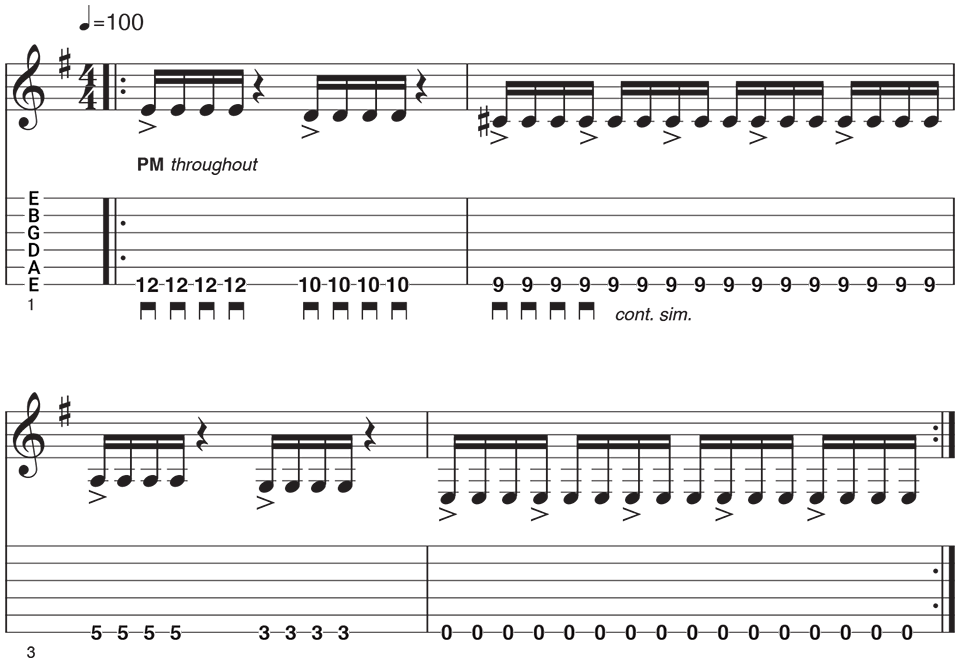
Examples of downpicking
Metallica - Master of Puppets
Many of Metallica's songs feature down picking riffs. These include Seek & Destroy, Creeping Death, And Justice For All, Blackened and the performance included here: Master of Puppets.
Watch and listen to how James Hetfield and Kirk Hammett use palm muted downpicking for the fast percussive riffing. This is famous – and technically infamous – for good reason.
Ozzy Osbourne - Crazy Train
This features Randy Rhoads' fantastic F# minor intro with 8th-note downpicking before the busier 16th note riff that shifts to the more cheery A major. An undisputed iconic rock/metal song fueled by the Les Paul virtuoso.
Status Quo - Down Down
Watch Francis Rossi and Rick Parfitt play this famous 8th-note based riff at the Glastonbury Festival in 2009. The balance of precision and stamina for the song's duration is harder than they make it look.
Notice many of their up-strokes are 'ghost' strokes that aren't heard, and when they do make contact it adds further rhythmic energy to the relentless downpicking.
Get The Pick Newsletter
All the latest guitar news, interviews, lessons, reviews, deals and more, direct to your inbox!
Jamie is a regular contributor to Guitar Techniques and Total Guitar magazines. He is also a Principal Lecturer in guitar and live performance at BIMM Bristol. Alongside this, he shares seven string guitar duties with Steve Smyth (ex-Testament, ex-Nevermore, Forbidden), in the modern thrash metal band One Machine. Additionally, Jamie is the UK brand ambassador for ESP guitars, where he creates product demos and delivers clinics across the UK and throughout the Scandinavian countries. More recently, he co-created the ESP School of Metal Guitar, where a team of versatile metal guitarists break down all things heavy.
- Jason SidwellTechniques Editor – GuitarWorld.com, GuitarPlayer and MusicRadar.com
You must confirm your public display name before commenting
Please logout and then login again, you will then be prompted to enter your display name.
![Metallica - Master of Puppets (Live) [Quebec Magnetic] - YouTube](https://img.youtube.com/vi/2f1Ny74_ou0/maxresdefault.jpg)

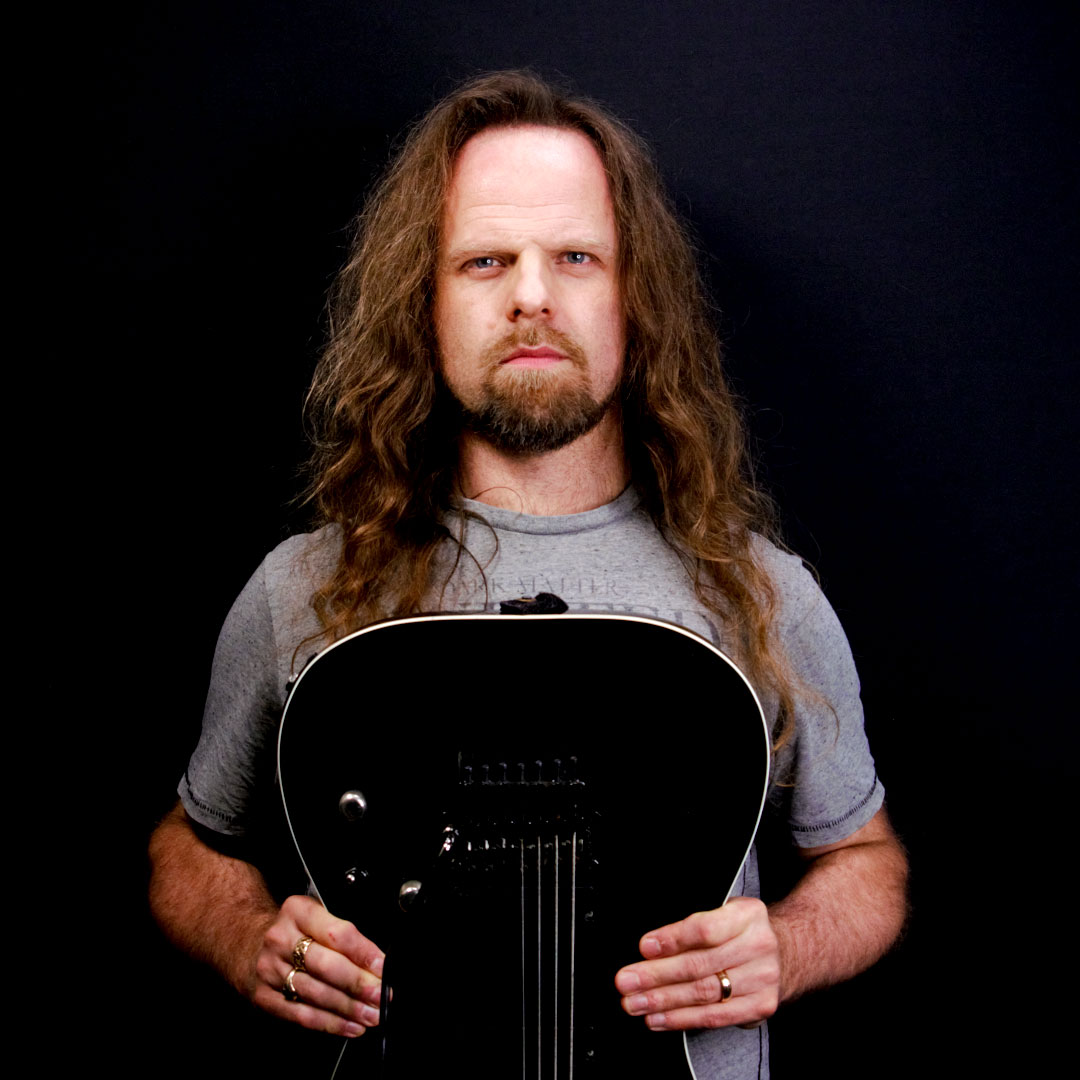








![Joe Bonamassa [left] wears a deep blue suit and polka-dotted shirt and plays his green refin Strat; the late Irish blues legend Rory Gallagher [right] screams and inflicts some punishment on his heavily worn number one Stratocaster.](https://cdn.mos.cms.futurecdn.net/cw28h7UBcTVfTLs7p7eiLe.jpg)

